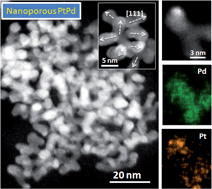Nanoporous twinned PtPd with highly catalytic activity and stability†
Abstract
Growing needs for highly efficient energy storage devices have prompted increasing research efforts in energy-efficient and sustainable materials. In this context, nanoporous noble metals have been studied extensively because of their extraordinary properties. However, existing electrochemical/chemical dealloying approaches for their synthesis largely lack the ability to optimize their structure/function relationships. To overcome this limitation, we developed a thermal-decomposition strategy for the synthesis of component-controllable nanoporous PtPd alloys composed of ∼2 nm sawtooth-like ligaments induced by a high density of twinning boundaries (boundary spacing ∼ 1 nm). Such twinned and ultrathin ligaments exhibit large curvatures between concave and convex regions, associated with abundant low-coordination surface atomic steps and kinks. These low-coordination atoms are sites of high catalytic activity, as confirmed by theoretical simulations. The optimized Pt25Pd75 sample exhibits the best catalytic performance among all the currently reported catalysts, and has a mass activity of 1110 mA mg−1Pt−1 and high stability for the electro-oxidation of methanol.


 Please wait while we load your content...
Please wait while we load your content...